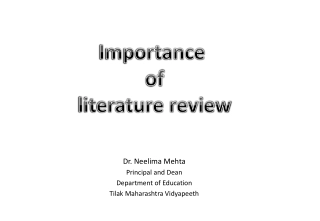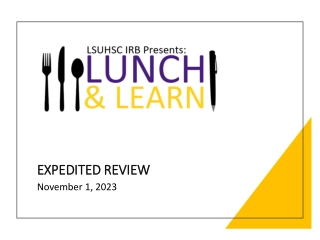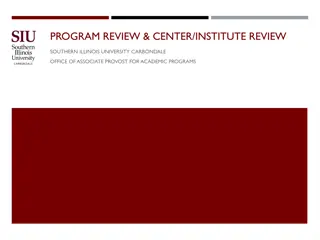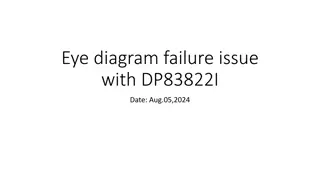Importance of literature review
A literature review is a critical component of any research endeavor, providing a comprehensive analysis of existing knowledge in a particular field. This review helps in clarifying conceptual issues, understanding research design, persuading examiners, and contributing new insights to the subject a
0 views • 28 slides
Understanding IRB Review Process for Expedited Research
Learn about the significance of IRB review, levels of review, and categories of expedited review. Discover the criteria for IRB review, including whether the study involves human subjects and contributes to generalizable knowledge. Explore the different levels of IRB review and the specific categori
4 views • 11 slides
SN65DSI85-Q1 Layout Review
In-depth analysis and review of the layout design for the 2026 Nissan CDC Headunit utilizing the SN65DSI85-Q1 system. The review includes detailed information on various layers such as Layer1 to Layer10, the schematic representation, and the block diagram outlining the PMIC Cluster ASIL-B setup. Key
0 views • 13 slides
Guide to PCB Design Steps by Subrat Kumar Pradhan, Asst. Prof. Dept. of ECE
Subrat Kumar Pradhan, an Assistant Professor in the Department of ECE, outlines the essential steps in designing a PCB. Starting from defining functionality and researching components to creating the system schematic, interacting with schematic parts, wiring connections, and laying out the PCB, this
5 views • 13 slides
Understanding Flowcharts for Document Management
Flowcharts are visual representations that depict the logical flow of processes within a system or program. They serve as communication tools and aid in documentation. Flowcharts follow specific guidelines such as top-to-bottom creation starting from the left of a page. Each activity within a flowch
6 views • 21 slides
Understanding Electricity and Circuits: Basics, Components, and Applications
This educational course covers topics such as circuit symbols, calculating and measuring electrical quantities, identifying circuits, and understanding the relevance of electricity in engineering. It explains essential circuit components like energy sources, conductors, insulators, loads, control de
12 views • 30 slides
Rapid Review of BSL Commissioning Arrangements by Dr. Michael Brady
NECS commissioned a Rapid Review of British Sign Language (BSL) service provision to identify areas for improvement in access and patient experience, especially during the Covid-19 pandemic. The review focused on stakeholder engagement, options appraisal for commissioning responsibility, and recomme
9 views • 19 slides
Understanding P&IDs and Symbols in Process Engineering
An insightful primer on P&IDs and symbols for students unfamiliar with EMEC125 and EMEC130 courses. The article delves into the definition of P&IDs as schematic diagrams illustrating the relationship between instruments, controllers, piping, and equipment. It explores the widely understood acronym "
1 views • 32 slides
Southern Illinois University Carbondale Office of Associate Provost for Academic Programs Review
The Program Review & Center/Institute Review at Southern Illinois University Carbondale aims to educate attendees on IBHE requirements, the review process, conflict of interest policies, self-study writing, on-site review involvement, financial support, and available resources. The IBHE mandates rev
0 views • 37 slides
Slate Graduate School & International Admissions Review Forms Overview
Explore the process of submitting review forms and making admission recommendations in Slate Graduate School & International Admissions, including automatic assignment of applications to queues, review of Staff Review Forms, and recommending admission or denial through Faculty Review Forms. Learn ab
0 views • 8 slides
Understanding Seismic Source Parameters in Earthquake Dynamics
The seismic source parameters in earthquake dynamics involve describing a fault as a discontinuity causing displacements, requiring a complex treatment of forces. The Earth's equilibrium necessitates a specific system of forces to explain displacements along faults. The seismic moment tensor, consis
4 views • 32 slides
Visual Insights into Schematic Failures and Bench Analysis
Explore detailed images showcasing schematic failures, analysis from schematics, web bench inputs, and re-compilation processes. Gain a deeper understanding of these visual representations in the context of technical failures and web bench activities.
0 views • 4 slides
Overview of Loop Diagrams in Process Control Systems
Loop diagrams are essential documents in process control systems, providing schematic representations of hydraulic, electric, magnetic, or pneumatic circuits. They detail instrumentation arrangements, signal connections, power connections, and termination information. Guidelines and standards for cr
1 views • 5 slides
PCB Design Best Practices and Tips
Discover the comprehensive process of PCB design, from the initial vision to schematic capture, component placement, and route tracing using tools like Eagle PCB. Learn about various package types, general tips for layout optimization, and recommendations for placing power and ground traces effectiv
0 views • 21 slides
Phase 4 Progress Review Discussion Template Overview
This template guides a Progress Review discussion involving a Customer, Provider, and Key Stakeholders. It addresses the gaps in common business requirements, risk assessment confidence, deployment readiness, budget impacts, migration costs, and more. The template provides instructions for completin
0 views • 25 slides
Conducting a BLDC Gate Driver Schematic Review and Debug Process
Exploring how to effectively review and debug a Brushless-DC (BLDC) motor driver schematic, focusing on locating EVM hardware files, understanding schematic recommendations, detecting errors, and providing valuable feedback. The process involves utilizing available resources to create, review, and d
0 views • 30 slides
Understanding Judicial Review in Administrative Law
In this chapter, the concept of judicial review in administrative law is explored, focusing on the scope of review set by Congress, including trial de novo and independent judgment on evidence. Different standards of review, such as clearly erroneous and substantial evidence, are discussed, highligh
0 views • 23 slides
Understanding Building Drawings in Graphic Communication
Building drawings play a crucial role in the construction industry, providing detailed plans for architects, builders, plumbers, electricians, and joiners. These drawings include location plans, floor plans, sectional views, elevations, and schematic diagrams, each serving a specific purpose in the
0 views • 11 slides
UNCAC Implementation Review Mechanism: Moving Towards the Second Cycle
The UNCAC Implementation Review Mechanism is progressing into its second cycle, with a focus on evaluating challenges and terms of reference at the conclusion of each review cycle. The performance assessment has highlighted achievements in enhancing awareness and involvement of civil society/private
0 views • 7 slides
Understanding Arbitrary and Capricious Review in Administrative Law
Arbitrary and Capricious Review refers to a highly deferential standard applied to agency decisions, requiring agencies to demonstrate compliance with statutory requirements. The landmark case of Citizens to Preserve Overton Park v. Volpe set the precedent for a thorough judicial review based on the
0 views • 8 slides
Understanding Paleoweathering of Paleosols in the Lake Superior Region
Explore the localities and ages of Paleoproterozoic granitic paleosols in the Lake Superior region through schematic profiles, A-C*N-K plots, compositional changes in saprolite relative to protolith, variation with depth, reconstruction of CIA and K2O in metasomatized samples, and mass balance equat
0 views • 17 slides
Understanding Mechanisms and Algorithms Lab Experiments
Explore the world of mechanisms and algorithms through engaging lab experiments involving Lego levers, shafts, cranks, electronics schematic drawings, and more. Learn essential concepts like reciprocating motion, understanding part roles, troubleshooting techniques, and rapid prototyping. Gain hands
0 views • 22 slides
Spatial Amplification in Disk-on-Rod Traveling-Wave Amplifier Study
Explore the viability of Disk-on-Rod Traveling Wave Tube (TWT) for high-power microwave devices with wide bandwidth. Analyze the spatial amplification rate through hot-tube dispersion relations, comparing against Particle-in-Cell code simulations. Schematic diagrams and cold-tube dispersion relation
0 views • 13 slides
Global Peer Review Activities and Future Plans Overview
This document highlights the recent peer review activities conducted by the Subcommittee on Peer Review, focusing on the accomplishments and upcoming plans for enhancing peer review processes. It includes insights from the Global Flyer Survey, training programs, and the development of guidelines, al
0 views • 3 slides
Feedback Loop Compensation Design Using UCC28740 for Voltage Regulation
Explore the detailed design and control laws for a feedback loop compensation system using UCC28740 in a flyback regulator schematic diagram. The control law profile in CV mode, multiple control regions, and gain blocks are discussed for achieving high efficiency in voltage regulation. Gain blocks d
0 views • 16 slides
Understanding Full Committee Review (FCR) vs. Designated Member Review (DMR) for New IACUC Members
Explore the differences between Full Committee Review (FCR) and Designated Member Review (DMR) for new IACUC members. Learn the acceptable methods of protocol review, federal requirements, member responsibilities, risks, and best practices for protocol approval. Dive into the two valid methods of IA
1 views • 23 slides
Program Review Annual Summary 2016 by PRC Committee
The Program Review Annual Summary 2016, prepared by the Program Review Committee (PRC), presents a detailed review of instructional programs and administrative units at the College. The report outlines the purpose of the annual review, the themes and issues identified, and recommendations for improv
0 views • 13 slides
Layout and Electrical Rules Check by KANTHARAJU P.K.
Layout rules check is essential in preparing masks for fabrication processes to ensure accuracy. Key design rules include minimum width, spacing, enclosure, and extension. Electrical rules checking (ERC) methodology is used to verify design robustness against electronic design rules at schematic and
0 views • 15 slides
Exploring Mitochondria: A Visual Overview for Researchers
Dive into the world of mitochondria with a collection of detailed figures, showcasing thin section views, fluorescent protein labeling, schematic representations of mitochondrial compartments, and involvement in processes like apoptosis and biogenesis. Discover the intricate structures and functions
0 views • 12 slides
Exploring Mitochondria: Images and Insights for Researchers
Dive into the world of mitochondria with a collection of informative images showcasing aspects like mitochondrial reticulum, fluorescent protein labeling, electron micrograph views, and schematic diagrams of mitochondrial compartments. Learn about metabolic pathways, cellular energy control, mTOR si
0 views • 20 slides
Windmill Project Management Overview
The Windmill project, led by PDR Scott Strycker, Koosha Daneshi, and Ian Nelson, involves a windmill design without a gearbox. The project includes a work breakdown structure, Gantt chart, level two functional decomposition, schematic, and risk mitigation plan. Key risk mitigation strategies include
0 views • 6 slides
Schematic Design Review for Project UF-100 Century Tower
During the Schematic Design phase of the UF-100 Century Tower project, the committee will assess the building footprint, site layout, and tree removal plans. The presentation guidelines outline key aspects to cover, such as project overview, site plan, tree impacts, and mitigation strategies. Visual
0 views • 9 slides
Understanding the Significance of the Cell Cycle in Growth and Development
This resource focuses on the cell cycle in the context of growth, development, and proliferation. It covers the significance of cell division, similarities in unicellular and multicellular organisms, the importance of CDK-mediated phosphorylation, and more. Students will learn to create schematic de
0 views • 24 slides
Uncovering Fabricated Data in Stem Cell Research: The Haruko Obokata Scandal
Haruko Obokata, a promising stem cell researcher in Japan, faced allegations of data fabrication, leading to a significant research scandal. Post-publication peer review platforms like PubPeer, PubMed Commons, F1000 Research, and ResearchGate Open Review play vital roles in detecting and addressing
0 views • 11 slides
Effective Strategies for Conducting a Literature Review in Research Methodology
Understanding the importance of literature review in research methodology, this chapter discusses the objectives, aims, and guidelines for writing a comprehensive literature review. It emphasizes the significance of identifying gaps in existing knowledge, structuring the review, and organizing infor
0 views • 33 slides
Understanding the Doctrine of Judicial Review in the United States
Judicial Review is a crucial power of the judiciary to review the constitutionality of laws and executive orders. This article explores the origin of Judicial Review in the United States, focusing on the landmark case of Marbury v. Madison. It delves into the concept, importance, and application of
0 views • 14 slides
PCB Design Tutorial Steps & Interactions
Learn the step-by-step process of designing a PCB, from breaking down functionality into modules to creating the system schematic, wiring connections, and PCB layout. Discover tips for component selection, interaction with schematic parts, and ensuring proper design rules are followed.
0 views • 13 slides
Enhancing Online Teaching Through Self-Review: Challenges and Benefits
Explore the self-review process of online teaching, including identifying challenges, benefits, and different types of reviews. Learn about developing an effective review guide, promoting collegiality, and facilitating professional development in online teaching. Discover the components of a review
0 views • 23 slides
Understanding the Standard Agreement Between Owner and Architect AIA Document B101
In this document, explore the AIA Document B101, which outlines the standard form of agreement between an owner and architect. Learn about the architect's basic services, including schematic design, design development, construction documents phases, additional services, termination or suspension cla
0 views • 35 slides
Troubleshooting Eye Diagram Failure Issue with DP83822I in Fiber Optic Schematic
Utilizing the Tektronix MSO 70404C oscilloscope and differential probe for testing, the customer encounters failure in the eye diagram test with the DP83822 IC. Suggested solutions from the BU and potential configuration of Reg0x0027 register in DP83822I to meet the eye diagram test requirements are
0 views • 5 slides







































